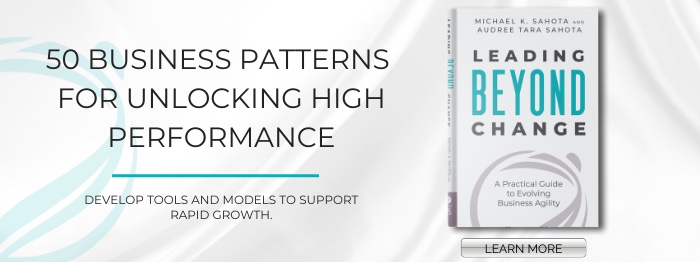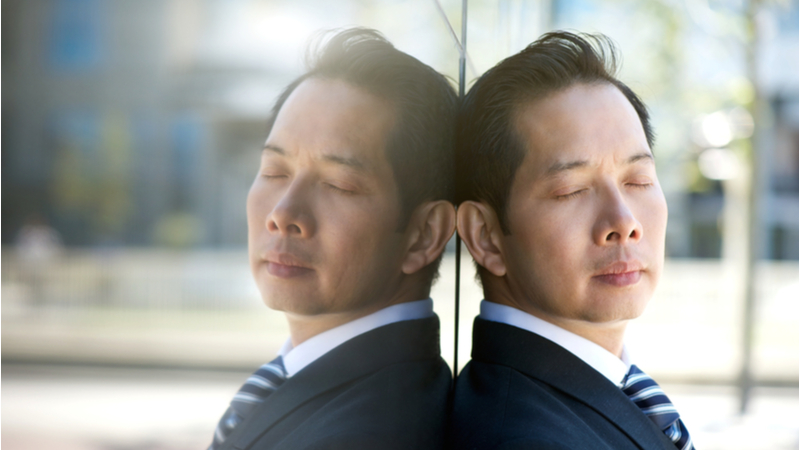What is a Teal organization and why should we care? Frederic Laloux wrote a powerful book called “Reinventing Organizations,” where he went through 10 different case studies of high-performance organizations. “Teal” is the code word for high-performance organizations that are able to exhibit extraordinary levels of performance, organizational success, and that operate in a very human-centric way. If you want a quick summary, check out our post Teal Organization – Future of Work.
Our definition of Teal is a variation from Frederic Laloux’s work. We offer a deeper insight into the core of his research. It’s this: the core of a Teal organization is that people act like adults. Ultimately, Teal is about deeply respecting people, treating them like adults, and in turn, having an environment where people show up and act like adults. What do we mean by acting like an adult? It is an organizational system where everyone shows up in a way that creates high performance. Simple to describe, however, how do we get there?
The Three Terrible Traps of Teal
Unfortunately, many organizations try to “go Teal,” without understanding how it actually works or what’s required to create a Teal organization. Here are the three most common traps people fall into.

#1 The Teal Blueprint Trap
The biggest mistake people make is thinking that Teal is a blueprint. They think that all you need to do is to take the Teal blueprint and implement that in your organization. However, people have been trying this for the last five years, and it doesn’t work.
Why doesn’t it work? Because Teal is not a blueprint, there are no defined structures of what creates a Teal organization. There are some popular structures that create Teal organizations, yet each organization has a unique DNA – cut and paste doesn’t work. What is most important even before you change the structures? The people must be able to function in the new ways of working. Teal is actually pointing to a different mindset and worldview, a way where people interact in a very fundamentally different way. Teal is not business as usual. You can’t achieve that by following a blueprint; each organization has to find its own unique journey.
Teal Is Not Business As Usual
#2 The Structures Trap
We’ve seen organizations that have actually painted the walls teal and installed teal carpets, thinking it would somehow help them create a Teal organization. This is an extreme example, yet it points to the larger problem of trying to copy structures without understanding what actually makes a Teal organization.
Because the book Reinventing Organizations doesn’t tell people how to create a Teal organization, it left a vacuum. And when people have a vacuum, they default to their baseline level of mindset or consciousness, which is that of a traditional organization, where the way we make change is by changing structures. Naive attempts to create flat organizations just don’t work … they fall flat of their hopes of creating profound change. Why? They are focused on the structures and not on the evolution of the people.

#3 Cargo Cult Teal Practices
The next trap is when organizations just copy Teal practices, like having transparent salaries or creating a flat organization, changing roles, and getting rid of hierarchy. Other examples include using the Advice Process or OKR’s from Google. More often than not, it’s a disaster. The practices are misunderstood from a less evolved level of consciousness. Or worse, people’s minds get blown up because they’re not ready for these types of practices.

There isn’t enough psychological safety within the organization to function in the Teal practices. People have not been working in business environments where they feel supported by management or have basic levels of functioning vulnerability to support Teal ways of working. The mindset and world views of business as usual are still the norm in most organizations.
Is everyone in your organization showing up inspired, self-motivated, and high-performing? Are people ready to share power, be totally transparent, collaborative with no agenda or ambition, and put self-interest aside for the sake of the organizational purpose? Most are not ready to fully, 100%, show up this way. People do not know how to step into that level of responsibility as individuals, no one has been taught how to lead and manage without using command and control.
How to Create a Teal Organization
How do you create a Teal organization? There are two requirements for anyone wanting to create a Teal Organization.

- Adult Behavior: You show up as an adult and take full responsibility for your behavior.
- Teal Leadership: You model the same types of behaviors and mindset as Teal leaders do.
Requirement #1: Adult Behavior
In a Teal organization, everyone is functioning at their very best, in their fullest potential no matter what is happening. Table stakes for Teal.
The key characteristic of a Teal organization is that people are expected to act like adults. This means that people take responsibility for their actions, their growth, how they function and their impact. Teal structures or the lack of typical organizational structures require a commitment from everyone on the team to take responsibility for their actions, be open, vulnerable and most important be able to perform at their best without formal structures in place that tell them what to do.
From that definition, we can see that most people do not understand what it takes to function in a Teal organization. Why is that? Because the personal evolution that is required to grow is not common. How many people do you know that are ready to be confronted by something so radical as taking full responsibility for their behavior? Think about how many times a day do you become frustrated, angry, or disengaged? Do you show up ready to learn and grow? Are you willing to look at your behaviors and their impact? And when do you get “taken out” and stop performing at your fullest potential?
We are not taught the tools and techniques for self-evolution and personal growth. This takes time, desire, and commitment 24/7, to grow into Teal like mindset and behaviors.

Requirement #2: Teal Leadership
The most basic requirement for creating a Teal organization is that the leaders themselves are capable of functioning in a Teal environment. To be Teal you must show up Teal.
At SHIFT314, we analyzed many case studies, both those in the book Reinventing Organizations and beyond, to discover a common thread. Teal leaders show up with an evolved mindset.
Did these leaders go to a special training program? No. Were they just born that way? No. What they did have is a willingness to evolve themselves and a desire to create a workplace where people would actually want to come to work. A place where people were treated like adults, not like mechanical machine parts, or patronizingly like family members. These leaders had enough of a shift in their mindset and their day-to-day practices that they were able to create a Teal organization over time.
Once we’ve evolved ourselves and we show up as a Teal leader, then a Teal organization or a group within our organization will naturally form around us because we’re going to be showing up and interacting with everyone differently, day in, day out. Over time, a Teal organization will evolve. But the preconditions are that we’re showing up in an evolved way, and we have a passion to create an environment where people can show up and do their best.
Practical Steps for Becoming a Teal Leader
But what if that shift hasn’t happened for you yet as a leader? With the SHIFT314 Evolutionary Leadership Framework™, we’ve created a coherent set of evolutionary practices to move from a traditional way of functioning as a leader, to a more evolved way. That’s what we call Evolutionary Leadership.

In the book Leading Beyond Change and in our Certified Agile Leadership courses, we have successfully mapped out the path, the skills, and mindset shifts needed to show up with an evolved consciousness. The book will be released in August of 2021. In the meantime, here are some pointers and resources to get you started.
Develop Self Awareness
The most important quality to evolve and function at your best is to develop self-awareness – becoming aware of how you are showing up as a leader. How are you impacting others around you? How are people responding to you? Just start becoming very aware of what we call “leadership edges” places where we have behavior patterns that are disruptive.
Are you really showing up as the ideal leader you hope to be? Being able to answer this honestly at any particular moment is self-awareness.
The best archetype I know of for a Teal leader is Ricardo Semler. I ask myself, “am I showing up like Ricardo Semler? How would he be showing up right now?” His video is a great example of what it is like to function from an evolved place.
Practice Evolutionary Leadership

The continual choice to evolve is what we call Evolutionary Leadership. Self-awareness plus the choice to evolve will lead to immense growth. Evolutionary Leadership is a defined set of characteristics such as the ability to dissolve the ego, navigate complexity, stay calm and stable, and develop others into leaders. One important characteristic is the choice of others to follow you, your very being transmits, inspiration, collaboration, positive influence, there is no pushing or command-and-control behavior.
This is the foundation of your evolution as a leader, and without these ingredients, it’s very difficult to make any substantial progress towards creating a Teal organization.
The question for anyone wanting to create impact externally is: are you ready to do what it takes? Are you ready to evolve yourself? Are you ready to look into your challenges and limitations to evolve into an inspirational leader that impacts evolution and high performance?
Cultivate Psychological Safety
When we have a high level of inner psychological safety, we will have enough blood supply to our frontal cortex and we can solve challenges in a very calm, resourced way. The problem is most of the time when there is a problem we go into fear, anxiety, worry, anger, or frustration. The blood supply going to our frontal cortex is shut off, we are in fight or flight mode. In a business-as-usual environment, we are actually functioning from these emotionally triggered states and we can’t operate at our best.
An essential part of creating a Teal organization is to be an Evolutionary Leader. One who is capable of developing the inner self to be a calm, stable presence. The ability to be calm in the midst of the storm creates the ability to solve any challenge that’s thrown at you.

At SHIFT314 we have developed the SELF™. These are integrated techniques and tools that guide accelerated growth so people can be the calm in the storm. A Teal organization requires Teal leadership or Evolutionary Leadership. It’s not business as usual – it’s conscious business practices.
New Ways of Being that Enable New Ways of Working
For more on psychological safety, see our articles about Creating Psychological Safety and Psychological Safety in a Remote Environment.
Surf Your Emotions
Emotional Science is a key to understanding how our emotions work. Most of us have been lied to about emotions and how they work. And we’ve been deceived into thinking that we can or should control our emotions. The truth is that we can’t stop emotions; they are a part of us. They’re like an ocean wave. It just happens. However, we can learn how to surf them – and that is the technology of Emotional Science. It teaches you how to surf your emotions.
It’s a Hero’s Journey
The path to creating a Teal organization is a hero’s journey. It requires us to go through our darkness, face our biggest challenges and fears, to develop new capabilities and skills. It requires us to develop a different outlook on people and the world, to be transformed as a leader and as a human being. It’s an extraordinary journey and it’s not for everyone. It takes courage and desire for something different. To rise above business as usual, create impact, and inspire change.



